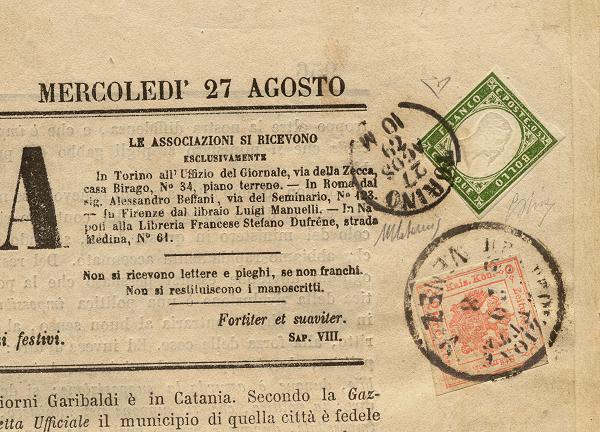|
2
Kr. green
|
Since
1853
|
|
1
Kr. black
|
Since
1858
|
|
2
Kr. vermilion
|
Since
1859
|
|
4
Kr. red
|
Since
1858
|
They were all printed
in Vienna in the State Printing House in the usual big sheets of 400 pieces
formed by two horizontal couples of 100 stamps printed in mirroring way and
separated by an inter-spacing of about 60 mm. The paper was, as usually, machine
made.
To a strict logic, we cannot define them postage stamps (in fact they are
not!) but they are historically considered as such and therefore collected
and classified by all the catalogues. It is not so rare to find them side
by side in a very nice group with other postage stamps from other States (with
relative leaving cancellation) that were applied to pay the relative postage
fee. I give here the example of a Sardinian newspaper (in fact at that date
it would be correct to say Italian...) that explains the concept better than
100 words...

Fig. 1: detail
of the newspaper "L'Armonia" of 08/27/1862
Carrying both the fee for the shipment of the newspaper (5c. of the 4th of
Sardinia)
as well as the Veneto tax paid with 2Kr. Vermilion.
By the way the newspaper white + the Sardinia green + the Veneto red form
an almost disrespectful Italian tricolor
Who knows if at that time they noticed the fact!!!! (Just a nice political
tax!)
For further details on these revenue stamps. I invite you to go to the single cards of each piece with a clarification:I have created separated cards for these values even if several catalogues are used to quote together the values of 1, 2 (red) and 4 Kreuzer, almost as they were a single issue. Instead just because their appearing was due to different reasons, I preferred to keep them separated.